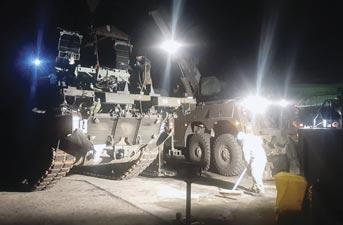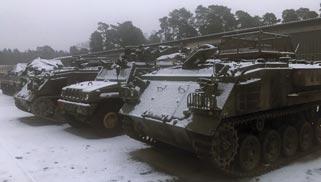
8 minute read
End to End REME Support: Part 2
Engineering in Action
End to End REME Support to enable Mission Ready Training
Advertisement
From Aug 20 until Jan 21, BATUS Workshops, 4 Armd CS Bn REME and 1 MERCIAN LAD provided a continuous REME chain which took equipment from BATUS and prepared it for Mission Ready Training in Sennelager, Germany. This three-part series shows the successes of this joint effort and a highlight an effective and truly collaborative delivery of equipment support.
Part Two: 9 Armoured Company, 4 REME
Op IRON KRANE
OC: Major John Vance
As the Army pushed to fulfil its commitment to the NATO Readiness Initiative, the COVID pandemic offered a unique opportunity for 3XX to realise this ambition by repositioning it’s @ readiness fleet in Germany. The in-load of 102 vehicles from BATUS meant a Lead Armoured Taskforce sized fleet could be stationed in Sennelager by 2021, accelerating the creation of NATO Forward Mounting Base whilst also enabling critical Mission Ready Training (MRT). The overall operation was IRON KRANE (IK) and 9 Armoured’s role was to complete the excellent initial repairs conducted by BATUS Workshops, before enabling handover to 1 MERCIAN in Jan 21.
For the task, the Company reorganised into three repair teams (Heavy A, Light A and B Vehicle Platoons) and oversaw the repair of 34 Land Training Fleet (Sennelager) (LTF(S)) vehicles, the receipt of the BATUS vehicles into Athlone, the BATUS fleet’s inspection and repair, and finally handover of the fleet for MRT. With over 110 people all working to a short deadline, the hard work and long hours that the team put in meant the target was realised. The operation was a truly joint effort - as well as being reinforced by the remainder of 4 REME and 12X units, the Company worked closely with LTF(S), BATUS Workshop and 1 MERCIANS LAD to maintain good communications on the state of the fleet.
From IRON KRANE there were huge positives. Our collective trade competency improved dramatically, particularly on AS90, T3 and PANTHER. Additionally, it allowed us to draw out deductions for the unit’s future role as a Divisional Troops Support Battalion and its expected tasks of breakout and activation. Finally, in the midst of the pandemic, it offered an operational focal point for our team to rally around and refined our readiness and preparation for war.
Experience of a new Platoon Commander
Scribe: 2Lt Ramsay
Having commissioned from Sandhurst in Aug 20 and finishing MSEC(L) soon after, I had the pleasure of deploying on Op IK on my first day in unit. After arriving at the hangar on my first day at 0400, we travelled by coach and arrived in Sennelager late that night.
After quickly finding my feet, I joined six Recovery Mechanics in Emden on day two. We provided recovery capability for the Port Task Group as they received the BATUS vehicle fleet and it provided me with a useful initial experience to understand the Recovery Mechanic trade and their thought process when it comes to different tasks. The time in Emden flew by and all 113 vehicles were successfully loaded onto Heavy Equipment Transporters and we returned to Sennelager.
Upon my return I took up the role of Support Platoon Commander where I was in charge of all of the enabling element of Op IK. This saw me leading a variety of different cap badges, including RAMC, KRH, RLC and REME. This exposed me to the different aspects which
Recovery Platoon at Emden on the Port Task Group

Night time pack change by the T3 line
Heavy A conduct a turret lift on a Challenger 2 Tank
are critical to the smooth day to day running of an operation and which are regularly taken for granted.
The first two months in unit were a fast and unexpected to start my career. During my time in Germany, I gained a solid understanding of the Recovery Mechanic trade as well as other trades and I can now take this forward during my time at 4 REME.
Unloading the BATUS Fleet at Emden
Scribe: Cfn Winfield
The port tasking at Emden was an opportunity to widen my knowledge on different types of vehicles and equipment. It allowed me to work alongside a variety of different cap badges who were all there to help. It also meant working with German civilian haulage contractors; which was difficult as we had to navigate the additional challenge of speaking a different language.
We arrived at the port where the cargo ship had docked. The first task was to move all of the vehicles, over 100 platforms, from the ship to the holding area; this prepared them for onwards movement to Athlone Barracks, Sennelager. Our job as Recovery Mechanics over the next six days was to move the vehicles that did not start or had no drive onto the Heavy Equipment Transporters. We craned on bridges and trailers and pushed on the dead vehicles until the vehicle park was empty and everything had departed for Sennelager.
It was a hard week’s work which allowed me to develop my skills and practice lifts which I don’t regularly do. This was my first port tasking and I’d really like to do it again.
Technical Challenges
Scribe: Sgt Grocock
Op IRON KRANE provided a new challenge for a lot of people in the Company. The strong working relationship we developed with the LTF(S) staff was critical to success and their assistance with spares, inspections bay, lifting equipment and infra was all helpful but there were still several challenges which we had to overcome whilst deployed:
1. MJDI/JAMES Link
We initially had some issues with the MJDI/JAMES link which slowed our ability to demand spares. This was remedied by transferring some of our team to the LTF(S) JAMES account which opened the connection to MJDI and allowed us to demand.
Although a solution, this did mean the process was lengthened our Class Ones would inspect the vehicles, add the faults and
4 REME soldiers work on Power Packs whilst in LTF(S) Soldiers from AS90 line working hard


3-2 presentation on the BD fuel system from Cfn Larkman
spares to JAMES, and then those on the LTF(S) JAMES would demand spares.
2. Modifications
BATUS had done a great job but we knew the vehicles still had a large amount of modifications to complete. By inspecting early and understanding that some modification spares would be delayed from the UK, we synchronised our work to complete of 16 BULLDOG exhaust modifications in the first month. This wasn’t easy, particularly when each mod could take between 3-8 hours and they often require additional metalsmith work to align the mounting holes properly.
3. Use of SV(R)
The workshop in LTF(S) wasn’t available to us, so most of the work was conducted in the vehicle sheds. The resultant lack of a gantry crane for all lifts meant the Recovery Mechanics had to assist with SV(R)s which added a level of complexity in the movement and allocation of the three SV(R)s available. Synchronisation was again key; particularly when the SV(R)s themselves developed faults.
4. Developing Competency
For several the team who were new to the Coy it was their first time away and working on armoured vehicles - they quickly stepped up and all trades were eager and quick to learn. This had the added benefit enabling some excellent 3-2 development, exposing the tradesmen to a wide variety of platforms.
Cold conditions for repairing vehicles outside

Charity Event - Miles for Stu
Welfare Support
Scribe: SSgt Shenton
Scribes: SSgt Metters & Cfn Shepherd
Op IK was the first operation 4 REME had deployed on during COVID19, resulting in a new kind of challenge where the welfare and safety of our soldiers required greater focus. Germany was locked down while we were deployed which meant no access to normal activities and entertainment outside of Athlone. Additionally, the camp had only been occupied by the small LTF(S) team for the previous few years meaning some of the previous welfare facilities were no longer there. Despite this our team made rapid improvements by bringing a FOB locker from Tidworth and acquiring gym equipment from Normandy Barracks to ensure we had great physical fitness facilities. Using funding from the Battalion, we fitted games consoles and TVs to the small recreation areas to provide an area for down time, and we conducted weekly PT challenges to provide an additional focus beyond the normal day-to-day routine.
Stu Carmichael is a former soldier who served 15 years in the REME and RE. In 2019 he received the devastating news that he had Motor Neurone Disease (MND). At huge financial cost, he was offered pioneering stem cell treatment in Mexico, and through a Go Fund Me page friends of Stu’s raised over £40,000 in the first couple of weeks.
To promote awareness of MND and raise further money for Stu’s treatment, soldiers from 4 REME attempted to cover the 9,627 kms distance from Quadalajara to Paderborn by run, cycle, walk or row over a 30-day period. Although there were initial worries about achieving the distance, as word spread the inclusive event became a great success with not only members of 4 REME but also friends of Stu’s requesting to join. The event gave many people a focus for fitness and some achieved impressive goals - 9 Armd’s WO2(CSM) Miller, SSgt Metters and Sgt Worth all completed 1,000 kms individually. By day 25 the challenge has been completed with a total of £1,162 raised. Stu has now undergone his treatment and we wish him and his family all the best with his recovery. Stu and I would like to say a big thank you to all those that helped cover the distance and kindly donated.










